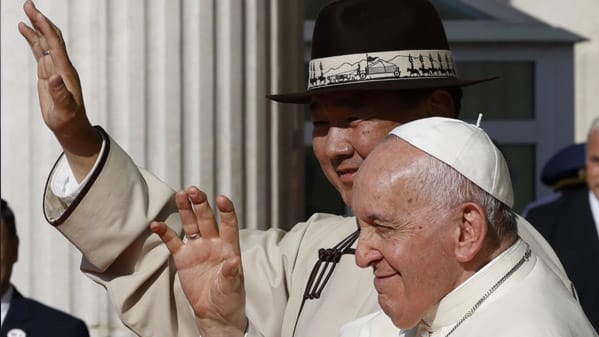By Ambassador Callista L. Gingrich
On September 1, Pope Francis arrived in Mongolia, marking the first time a pope has traveled to the East Asian nation and his 43rd Apostolic Journey abroad. The Holy Father’s Apostolic Journey to Mongolia is both historic and significant.
Pope Francis received a warm welcome at Ulaanbaatar’s Chinggis Khaan International Airport and began his official meetings and events on September 2.
On his first full day in Mongolia, Pope Francis attended a welcome ceremony and visited with President Ukhnaagiin Khurelsukh and other government officials. The Holy Father signed the official guest book and wrote, “As a pilgrim of peace in this country young and ancient, modern and rich in tradition, I am honored to walk the paths of encounter and friendship, which generate hope. May the great clear sky, which embraces the Mongolian land, illuminate new paths of fraternity.”
In his first official speech of the visit, addressed to civil authorities, Pope Francis celebrated Mongolia’s eagerness to “play an important role on behalf of world peace.”
In his address, the pope also gave credence to the contributions of Mongolia’s small but vibrant Catholic community, and its “desire to share its life and work in a spirit of responsible and fraternal service with the Mongolian people, which is also its own people.”
Following 70 years of communist rule, a peaceful democratic revolution in 1990 led to Mongolia’s transition to a multi-party democracy with a constitution that guarantees religious freedom. According to the U.S. Department of State, “Since 1991, Freedom House has rated Mongolia, the only post-communist consolidated democracy in Asia, as a politically free country.”
The Holy Father remarked, “A profound spiritual sensitivity belongs to the very fiber of your cultural identity, and it is proper that Mongolia should be a symbol of religious freedom.”
After the collapse of the Soviet Union and beginning in 1992, previously exiled Catholic missionaries returned to the country to rebuild the Church. Today, less than 1 percent of the country’s 3.3 million people are Catholic, numbering approximately 1,450 Catholics. Mongolia has just 25 priests, 33 women religious, and no more than eight Catholic parishes.
Also on September 2, while meeting with bishops, priests, missionaries, consecrated persons, and pastoral workers at Saints Peter and Paul Cathedral, Pope Francis offered assurance and noted that “being little is not a problem.”
Although Mongolia has one of the world’s smallest Catholic populations – led by Cardinal Giorgio Marengo, the youngest member of the College of Cardinals – Pope Francis reminded the local missionaries that “God loves littleness, and through it, he loves to accomplish great things.”
On September 3, Pope Francis presided over an ecumenical and interreligious event that included representatives of Shintoism, Buddhism, Islam, Judaism, Hinduism, Shamanism, and various Christian denominations.
Calling to mind the theme of the Apostolic Visit, “Hoping Together,” Pope Francis said, “Brothers and sisters, our coming together here today is a sign that hope is possible. … May the prayers we raise to heaven and the fraternity we experience here on earth spread seeds of hope. May they be a simple and credible testimony to our religiosity, our walking together with eyes lifted to heaven, our living in this world in harmony.”
That afternoon, Pope Francis celebrated Mongolia’s first papal Mass, which was attended by Catholics from South Korea, Vietnam, the Philippines, Russia, China, Hong Kong, Thailand, Kazakhstan, Kyrgyzstan, and Azerbaijan.
On September 4, before departing for Rome, Pope Francis spoke to a gathering of charitable organizations and volunteers and inaugurated the House of Mercy, a new clinic and shelter for the homeless, people with disabilities, and victims of domestic violence.
In Mongolia, one-in-three people live in poverty. Though small, Mongolia’s active Catholic community is reaching out to the broader local community through educational centers, orphanages, shelters, and nursing homes.
As Pope Francis noted, missionaries to Mongolia in the 1990s “Immediately sensed a summons to works of charity, which led them to care for abandoned children, our homeless brothers and sisters, the sick, the disabled, prisoners and all those who, amid suffering, sought their care.”
The Holy Father then added, “Today we see that, from those roots, a tree has grown, branches have spread out and much fruit has appeared in the form of a variety of praiseworthy charitable initiatives.”
Pope Francis’s historic Apostolic Journey to Mongolia brought encouragement to the country’s small Catholic population and a message of hope, fraternity, and peace to the Mongolian people.


